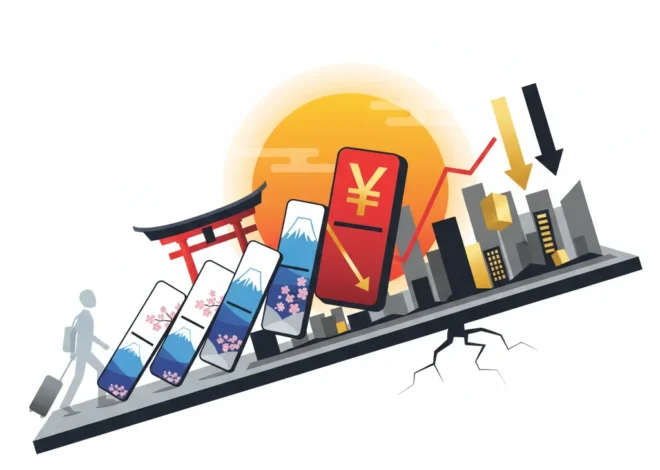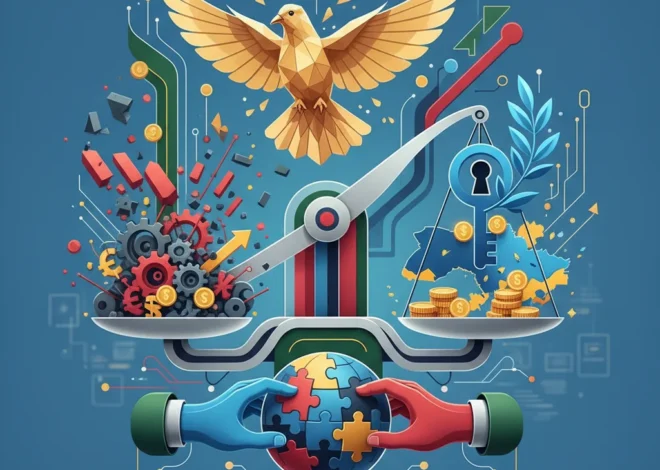
Beyond the Pitch: The Investment Thesis for Scotland’s 2026 World Cup Qualification
A Sporting Triumph, An Economic Catalyst
In a historic moment for the nation, Scotland has officially secured its place in the 2026 FIFA World Cup. While the roar of the Tartan Army celebrates a long-awaited return to football’s grandest stage, for investors, economists, and business leaders, the real game is just beginning. A nation’s qualification for such a prestigious global event is far more than a sporting headline; it’s a powerful economic signal, a catalyst for growth, and a unique opportunity for strategic capital allocation. The implications for the Scottish economy, its key industries, and the broader UK stock market are profound and warrant a detailed analysis.
This qualification is not merely about 90 minutes on a pitch. It represents a multi-year economic event-cycle that will touch everything from tourism and infrastructure to retail and cutting-edge financial technology. Understanding the direct, indirect, and intangible financial benefits is crucial for anyone looking to navigate the investment landscape in the coming years. We will dissect the macroeconomic impact, identify key sectors poised for growth, and explore the innovative ways fintech is shaping the modern sports economy.
The Direct Economic Kick-Off: Quantifying the Immediate Windfall
The most immediate and quantifiable impact of World Cup qualification comes from direct economic injections. This “first-half” effect is driven primarily by tourism, hospitality, media rights, and merchandising. The global spotlight on Scotland will attract a significant influx of international visitors, not just for the tournament itself, but in the crucial two-year build-up period. This surge translates directly into revenue for hotels, restaurants, and transport services.
According to preliminary economic modeling, the qualification is projected to boost Scottish tourism revenue by an estimated £750 million over the next three years (source). This isn’t just a London-centric boom; the focus on the national team will drive “fan tourism” to cities like Glasgow, Edinburgh, and Aberdeen, creating a more distributed economic benefit. Furthermore, the global broadcasting of qualification matches and pre-tournament friendlies generates substantial media revenue, a portion of which flows back into the national football association and the local economy.
Below is a breakdown of the projected direct revenue streams:
| Revenue Stream | Projected Value (2024-2027) | Primary Sectors Impacted |
|---|---|---|
| Increased Tourism & Hospitality | £750 Million | Hotels, Food & Beverage, Airlines, Rail |
| Merchandise & Retail Sales | £200 Million | Retail, Apparel, E-commerce |
| Media & Broadcasting Rights | £120 Million | Media, Advertising, Telecommunications |
| Sponsorship & Corporate Partnerships | £150 Million | Banking, Automotive, Consumer Goods |
The Ripple Effect: Infrastructure, Construction, and the Stock Market
Beyond the immediate cash injection, the qualification triggers a second, more powerful wave of economic activity. Hosting pre-tournament training camps, fan zones, and international friendlies necessitates upgrades to existing infrastructure. This includes stadiums, training facilities, transportation networks, and digital connectivity. The Scottish government and private sector partners will likely accelerate capital expenditure projects, creating a boon for the construction, engineering, and materials sectors.
For investors, this presents a clear signal. Companies involved in these sectors are likely to see increased contract flows and improved earnings forecasts. An estimated £400 million in targeted infrastructure spending will be required to meet international standards and accommodate the influx of fans and media (source). This creates opportunities not just in equity investing in publicly-listed construction firms, but also in infrastructure bonds and real estate investment trusts (REITs) focused on hospitality and commercial properties.
The UK's £30 Billion Question: Why Labour’s Tax U-Turn Changes Everything for Investors
The “feel-good factor” associated with national sporting success should not be underestimated in its effect on consumer confidence. A confident consumer is more likely to spend, boosting retail sales and the services sector. This sentiment can provide a tailwind for the domestic stock market, particularly for consumer-discretionary stocks. While it’s crucial to separate sentiment from fundamentals, historical economics shows a clear, albeit temporary, correlation between major sporting achievements and positive market performance.
Fintech Takes the Field: The Digital Transformation of the Fan Economy
The 2026 World Cup will be the most digitally integrated sporting event in history, and Scotland’s participation provides a fertile ground for fintech and financial technology innovation. The modern fan experience is powered by seamless digital transactions, and this event will accelerate the adoption of new financial platforms.
Key areas where fintech will play a pivotal role include:
- Cashless Venues: Stadiums and fan zones will operate on entirely cashless systems, driving massive transaction volumes through payment processors and digital wallet providers. This is a significant opportunity for both established banking players and agile fintech startups.
- Blockchain and Ticketing: To combat fraud and scalping, expect to see the use of blockchain-based ticketing systems. NFT (Non-Fungible Token) tickets can provide secure, verifiable proof of ownership, creating a more transparent and efficient secondary market for trading tickets.
- Fan Tokens and Engagement: The rise of fan tokens, a type of cryptocurrency, allows supporters to engage with their team and participate in minor club decisions. This new asset class represents a fusion of finance and fan loyalty, creating new revenue streams for sports organizations and novel speculative assets for traders.
- Embedded Finance: Travel and hospitality platforms will increasingly embed financial products—like travel insurance, currency exchange, and “buy now, pay later” (BNPL) options—directly into the booking process for fans traveling to see the team.
The Paradox of India's Growth: Why a Booming Economy is Begging for a Spending Spree
This technological integration is not just a convenience; it’s a core part of the modern sports business model. It creates vast amounts of data that can be used to personalize fan experiences and optimize marketing spend, further enhancing profitability.
The Long-Term Trophy: National Branding and Foreign Investment
Perhaps the most significant, albeit hardest to quantify, benefit is the long-term enhancement of Scotland’s national brand. A successful and visible presence at the World Cup is an unparalleled global marketing opportunity. It showcases the country as a vibrant, modern, and capable nation, which can have a powerful halo effect on foreign direct investment (FDI) and skilled migration.
Studies on the economic impact of hosting major events, which can be extrapolated to a high-profile participation, show a sustained increase in tourism and investment for up to a decade afterward. One analysis suggests that countries qualifying for the World Cup see an average export growth of 5% in the subsequent two years (source), as the “Made in Scotland” brand gains global recognition. This provides a compelling long-term investment thesis that extends far beyond the final tournament.
Here is a simplified comparison of the short-term costs versus the potential long-term benefits:
| Metric | Short-Term (2024-2027) | Long-Term (2028-2035) |
|---|---|---|
| Primary Driver | Event-driven spending (Tourism, Infrastructure) | Enhanced National Brand (FDI, Export Growth) |
| Financial Focus | Direct Revenue & Capital Expenditure | Return on Investment (ROI) & GDP Growth |
| Key Sectors | Hospitality, Construction, Retail | Technology, Higher Education, Financial Services |
| Risk Profile | Cost overruns, short-term volatility | Failure to capitalize on momentum |
A Note of Caution: The Risks of the Game
No investment thesis is complete without an analysis of the risks. While the upside is significant, a professional approach requires a clear-eyed view of the potential downsides. The history of major sporting events is littered with examples of over-optimistic financial projections. Cost overruns on infrastructure projects are a common pitfall, with some historical events seeing budgets swell by over 150% (source). It is imperative that public and private investments are managed with strict fiscal discipline.
Furthermore, there is the risk of a “substitution effect,” where money spent on football-related activities is simply diverted from other parts of the consumer economy, leading to a net-zero gain. The economic benefits are not guaranteed; they must be actively cultivated through strategic policy, efficient execution, and a concerted effort to translate the short-term spotlight into lasting international partnerships.
The European Paradox: Why Stronger Nations Might Build a Stronger Union
Final Whistle: The Investor’s Playbook
Scotland’s qualification for the 2026 World Cup is a landmark achievement with tangible economic and financial consequences. For the astute investor, this is a moment to look past the cheering crowds and analyze the underlying fundamentals. The opportunity extends across multiple sectors, from the obvious plays in tourism and construction to the more nuanced, high-growth potential in fintech and digital fan engagement.
The key is to adopt a multi-faceted strategy: identify the short-term beneficiaries of the direct economic stimulus, position for the medium-term infrastructure cycle, and maintain exposure to the long-term upside of an enhanced national brand. While the journey to 2026 will be filled with the passion and unpredictability of sport, the economic principles at play are clear. By understanding the dynamics of this unique event, investors and business leaders can position themselves to score their own significant returns.


